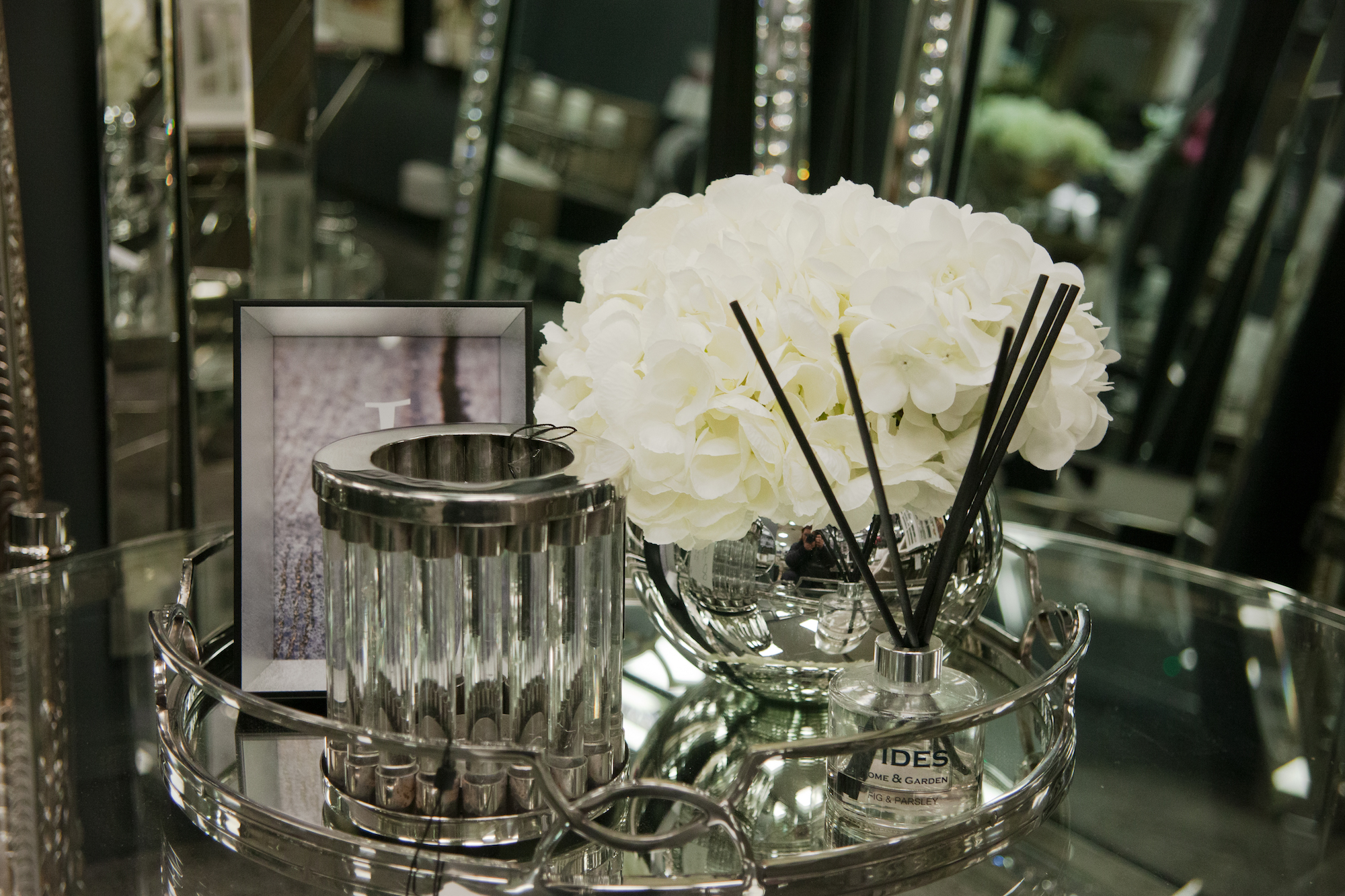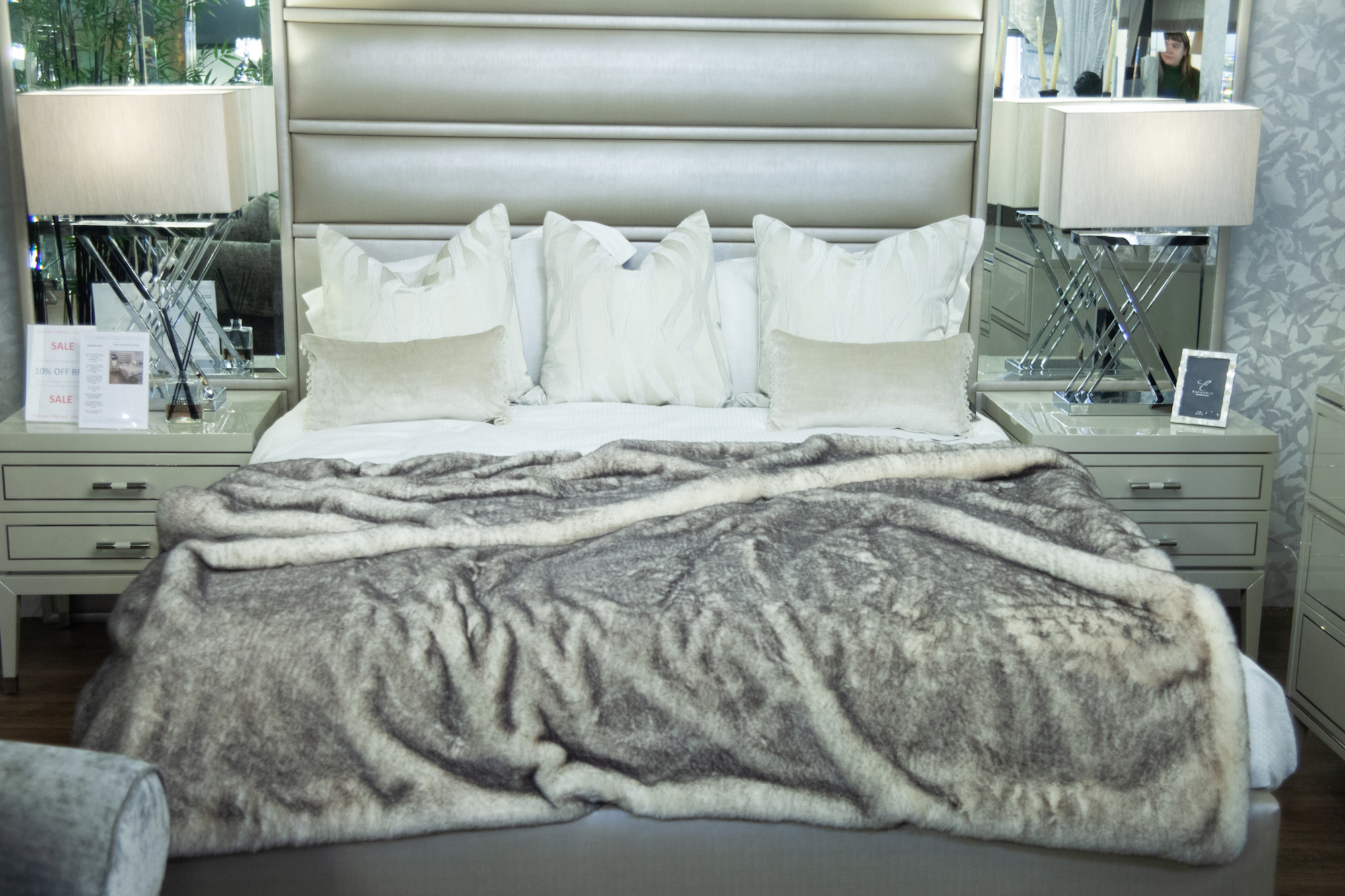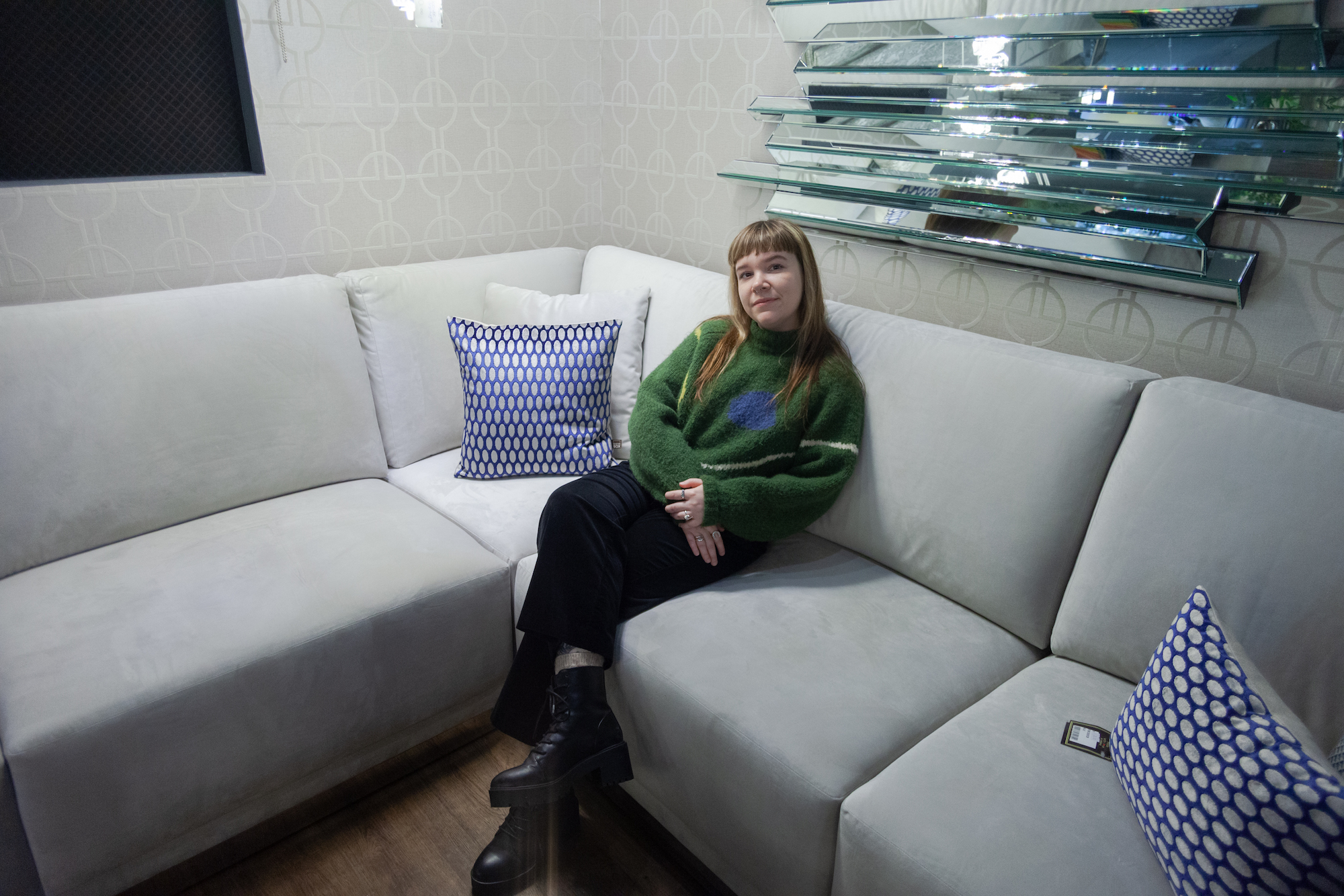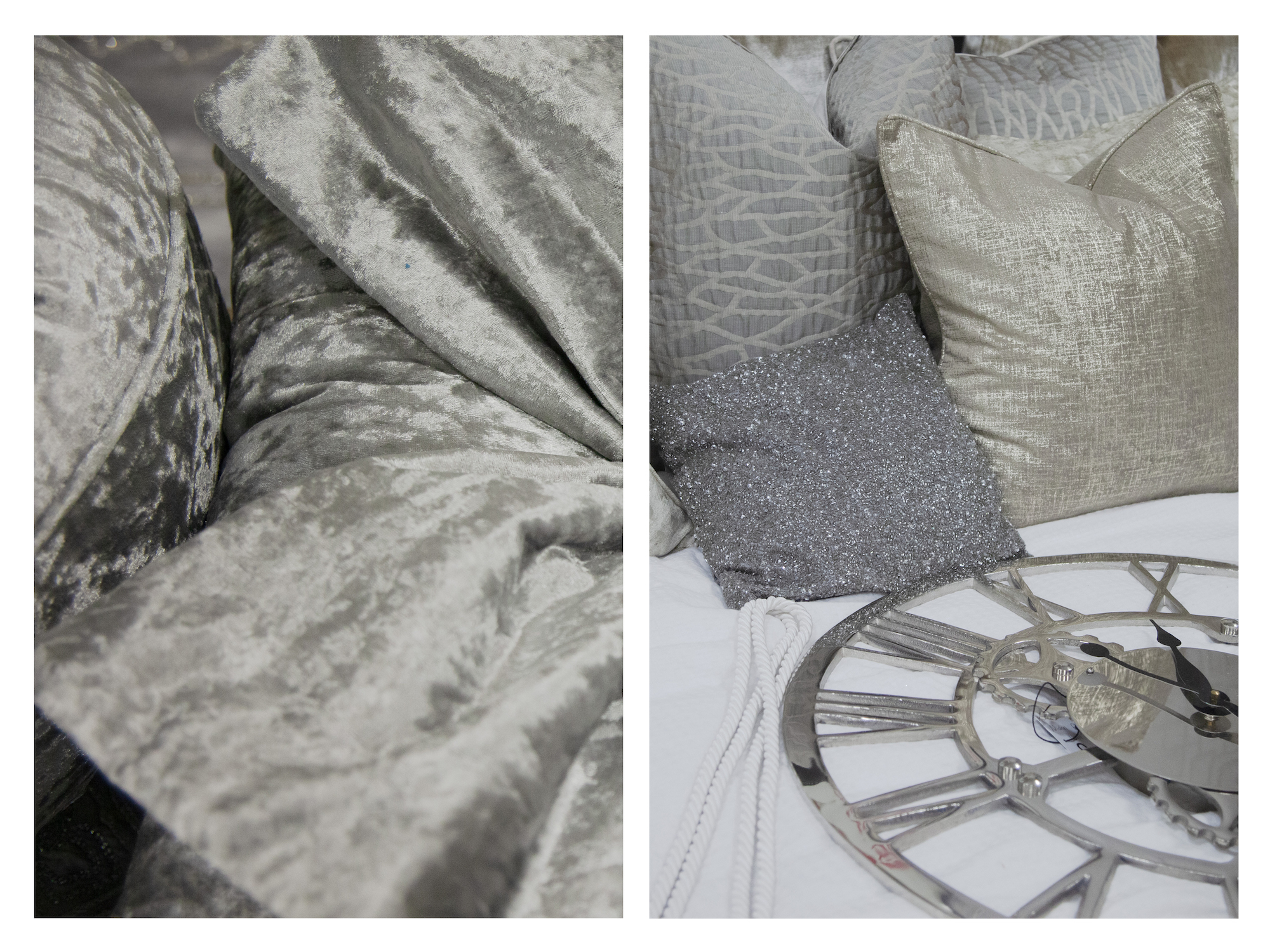It’s a dreary Essex morning, and I’ve come to an interiors home shop in Brentwood to see a woman about a couch.
I find Tides Home and Garden’s two cosy high street storefronts, nestled among beauty salons and chain cafés. Their first shop sells tables, ornaments, and small furniture, while the other houses Tides’ own bespoke interior design service. Each stands resplendent with Footballers’ Wives crystal lighting, massive mirrors, and beds so cushioned and luxurious that they might as well have waddled off the set of Sofia Coppola’s Marie Antoinette. Basically every item is a neutral, comforting shade of silver or gray.
You’ll recognize the All Gray Everything home look favored by Tides and their customers if you follow a certain type of British influencer or reality star on Instagram. Often, when these women— Love Island alums like Dani Dyer and Molly Mae Hague; beloved cleaning oracle Mrs. Hinch, via the Geordie Shore girls—show off their homes online, the rooms tend to follow certain trends. Picture: silvery furnishings with smooth glass or marble surfaces; soft, velvety textures; and a sort of pillowing effect on upholstery that my recent forays into the world of furniture tell me is known as “deep buttoning.” In most cases, however, this aesthetic is assembled around an immovable center of gravity: the Big Gray Sofa.
Indeed, as Tides’ owner Jo Bristow, a glam blonde with a voluminous faux-fur coat and a kind, pub landlady manner, shows me around, it doesn’t surprise me that she describes a large, gray corner couch with a row of chrome studs along the bottom as one of her bestsellers. This style of chair—a sort of enormous haute cat bed for humans, often with curved, Italian-style arms, and buttoned detail—is a contemporary interiors phenomenon, having jumped from big British influencers’ social media accounts into the homes of thousands. But how exactly did this impractically huge, gray sofa become one corner of Instagram’s favorite interiors trend? And what does it mean for our physical living areas when home fashion originates in the virtual space of the internet?
*
Interior designer Simon Rawlings remembers when beige, not gray, was the favored hue of home decorators. “If you look back a few years ago, every advertisement for a large sofa was probably beige or brown. Now, gray has almost filled the gap,” he tells me. He thinks the reasons for that shift lie in gray’s universality. “Gray has become this color that’s synonymous with good taste. It’s not seen as dull or drab or boring anymore—it’s seen as very elegant, very desirable, but you do see it in all sorts of different scenarios,” including the more ‘budget’ sections of shops like H&M Home and Zara Home.
Jo says that she first noticed gray furniture rise in popularity six or seven years ago, and her customers have been requesting it ever since. “We’ve been 15 years in Brentwood, and we definitely adapted to what people were asking for,” she says, giving me an example: “I’ve been trying to bring gold into the shop for six years—but people in this area are not interested. People still love the gray and chrome.” Gray—more than gold—speaks to what she calls a “sort of glamorous, affordable high-end” style that people from the local area like.


As she mentions, the location of Jo’s stores is important, both in terms of what she chooses to stock and to the wider gray sofa and interiors trend. Brentwood, famously, is TOWIE country, and Tides is the furniture supplier to its sparkliest stars (as if to confirm its supremacy, Gemma Collins visited Tides during her segment on MTV UK’s 2019 Cribs reboot.) When it began in 2010, The Only Way Is Essex, along with Made In Chelsea, was one of the first British ‘structured reality’ shows to center on an aspirational lifestyle. The homes of its stars, therefore, became influential in a new way and on a national scale (see, for example, breakout star Joey Essex giving Heat magazine a tour of his home, which featured a faithful gray corner unit, back in 2014; a 2015 TOWIE episode where Arg and Lydia flirt in his gray-n-chrome kitchen over a stiff-looking oven pizza.) These preferences were then replicated even further as a result of social media, and the evolution of reality stars into online influencers.
As people become brands online, so too do their homes and lifestyles. In turn, influencer-endorsed trends then filter down to the rest of us. Like clothing companies partnering with highly-followed Instagrammers to shift more neon boob tubes, some savvy furniture businesses started to see the potential for Instagram-based influencer marketing. One of these is Arighi Bianchi, a Macclesfield-based furniture store that has gifted Big Gray Sofas to high profile reality stars-come-influencers like Molly-Mae Hague and Tommy Fury (who live together in Manchester), and more recently last year’s winner Amber Rose Gill, in exchange for exposure to their considerable audiences.

“The point of those sofas, they're lying down sofas,” says Robert, one of Arighi Bianchi’s owners, telling me about this style’s popularity. “The sofa is the only piece of furniture that you have in your room, and it's about chilling out on it.” He says it’s most popular among customers with open plan living spaces (still very popular in the UK and beyond) and wall-mounted TVs, which give this luxurious, statement piece sofa the floor space it needs. “It's a lifestyle being driven by what you're being exposed to on marketing channels,” says Robert.
Arighi Bianchi are a large part of that. They’ve been hugely successful online, thanks to high-profile influencer marketing and their own Instagram presence (more than 110,000 followers deep). Robert says both are “primarily driving the online side, which clearly, every year, is getting more and more important.” The reality stars that the brand tends to work with embody the exact type of accessible opulence that Arighi Bianchi wants to sell—part of the appeal is that, put bluntly, these women are ‘just like’ their audience, in that they often hail from ordinary backgrounds, but have become wealthy and thus adjacent to exclusive events, social circles, and other markers of aspiration. “We’re embracing social media, which is like word-of-mouth for the 21st century,” Robert concludes. It’s a no brainer.
*
The Big Gray Sofa and its associated aesthetic has taken off nationally largely because it has been promoted by a soft, velvet ouroboros constituted of influencers, influencer marketing and Instagram (a 2018 Fast Company article exploring Instagram’s effect on the interior design industry put it best: “People like the things they see on Instagram, and they’re on Instagram because people like them.”) Lauren Gilbey, who manages a pre-school as her day job, was inspired by the gray trend on Instagram when decorating her Essex home—of which she posts immaculate images via her account, @the_cubbyhole. She tells me what she enjoys about the style: “I'm really into glam decor, so for me gray velvet, and in general gray interiors, really bring that feel to a home.”
Lauren of course has her own Big Gray Sofa (a huge corner couch with chaise longue style arms). As well as finding it practical and durable, she adds the fact that “gray has become quite a luxurious color trend in recent years—it’s a very popular color used in homes that are being seen by a wide range of followers.”
It’s interesting to hear someone talk about their home decor in terms related to how strangers online would view their choices, but it’s not especially surprising. After all, Instagram and Pinterest have helped to forge our current lifestyle economy—both an attention economy and a financial one. Maybe the most widespread interiors trend to emerge from app-driven aesthetics is what Kyle Chayka, the author of Minimalism: The Longing for Less, terms “Airspace.” Simply defined, this is the minimalist look associated with hipster cafés and Airbnbs globally (the ‘oat latte’ of interior design). Airspace, at its most sinister, has effectively flattened local variety, and come to be seen as the aesthetic of gentrification and whitewashing.
I’m curious about the Big Gray Sofa as an item that has, like Airspace, proliferated through the physical spaces of so many people based on its appearance online. Certainly, there have always been aspirational home trends, from wood panelling in the 1950s to 70s shag carpets in the west, as popularized on TV and in magazines. But the difference with the Big Gray Sofa is that though it was initially a localized trend (Jo from Tides repeatedly associates it with places famed for the big-haired glamour of their residents, like Essex and Liverpool), it has widened nationally almost entirely via Instagram.

I asked Kyle whether, when we install interiors trends we’ve seen online in our actual homes, this changes our expectations of what our living spaces are, and what they are for. He tells me: “So much of culture now we consume purely on screens. I think it does affect what kind of aesthetics and styles we look for and what we end up desiring. There's a vaporous-ness to a lot of things that get popular on the internet; it's like a digital aesthetic gets applied to real-world objects.” Though their color is certainly practical, when you think about the sheer size of some of the Big Gray Sofas proudly showcased by furniture stores and influencers, it is easy to see how online impressiveness might outweigh livability. Indeed, throughout my conversation with interior designer Simon, he marveled at the sheer scale of the things, wondering aloud: “Something that baffles me when I see them online is, how do people have houses big enough to put them in?”
Ultimately, the Big Gray Sofa is a symbol of just one of the ways you can see technology’s influence encroaching upon our private homes: to my mind, in some ways, you can place it alongside the Ring doorbells and so-called smart fridges of the world. And of course, where there is mainstream technology, a financial motive usually doesn’t linger far behind. Kyle explains: “Particularly with sharing-economy platforms, it's not just that we're influenced by capital in what we consume, but our objects have to kind of be liquid capital themselves. We rent specific furniture to make a temporary apartment feel more like a permanent home, or we decorate our leased apartment so it plays better on Airbnb and makes more money.”
This is, however you feel about it, now simply just the way of things. As Kyle puts it, “Social media accounts play a huge role in how all trends proliferate now.” It would be wrong to categorically state that this is necessarily harmful in the context of our homes. Lauren, for example, says that she styles her home for her own enjoyment, which “always comes before Instagram; as long as my home makes me feel happy then that's what’s important,” and adds that she take lots of photos of her interiors at once, to post over time, which means that her home doesn’t have to be in peak condition all the time, while also creating an illusion of a near-perfect state online.
The online growth of the Big Gray Sofa does, however, tell us a lot about our ever-closening relationships to the internet and capitalism. You pick up your phone to see what your friends are posting, and you’re sold a couch in the process. You design your living space genuinely considering what it might look like through the frame of your phone camera. Our homes—extensions of our very selves—have more potential to be involved in transactions of currency, both real and social (which is real too), than ever.
Sometimes, a sofa is just a sofa. But most of the time—especially now, in our endlessly connected and rampantly financialised moment—it’s not.
This article originally appeared on VICE UK.
from VICE https://ift.tt/31a7rKj
via cheap web hosting
No comments:
Post a Comment